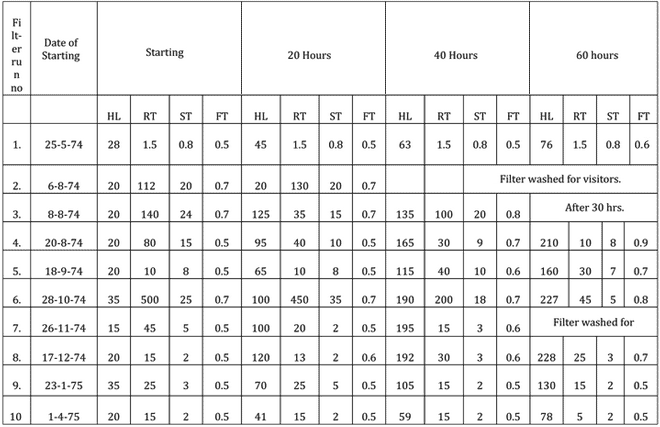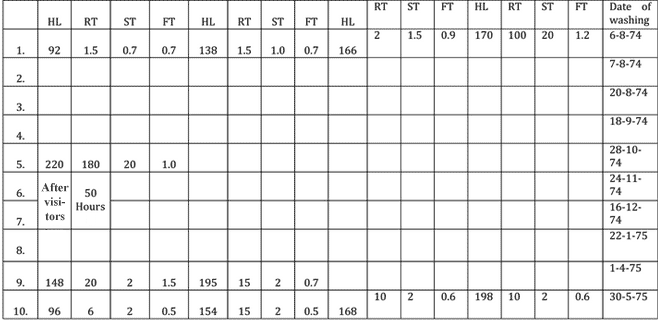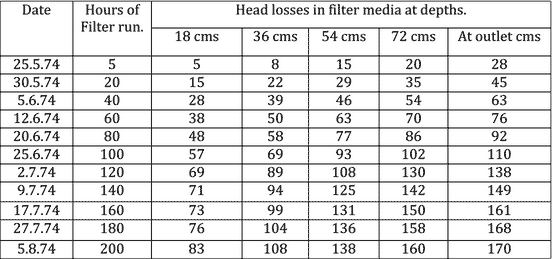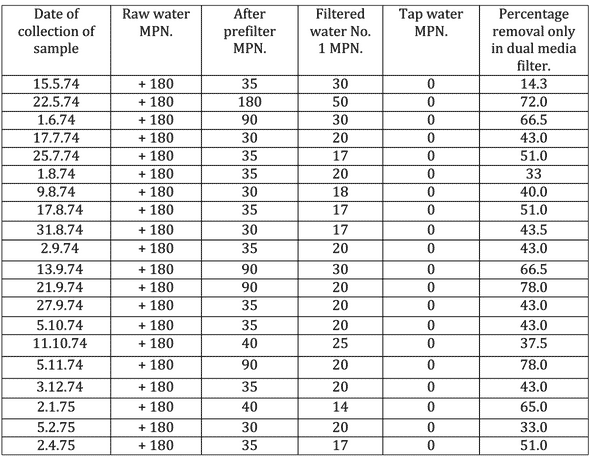| 1. |
Introduction : |
| |
The filtration plant at Ramtek, near Nagpur has been designed utilizing new basic objective of developing a simple and cheap filter for rural areas and small towns. In this plant, gravel bed pre-filter has been provided in place of the rapid sand filter. The plant consisting of two such units, has been designed for the pumping rate of 1, 00,000 liters per hour with the capacity of 2.4 MLD (say 0.5 mgd). The technical details re: The plants, designed and constructed by the author in the year 1973, were published in paper presented at the 6th Annual convention of Indian Water Works Association held at Baroda in Feb. 1974. As stated in the paper, one of the dual media filter bed was run for a higher rate of 9650 lit/sq.m./hour. (215 gallons / sq.ft./hour) from 1-5-1974 for actual plant observations.
The principle object of this paper is to present the plant scale observations running over a period of one year, and to consider the possibility or otherwise of adopting such a filter unit for higher rates in rural and semirural areas. The new filter has not only given satisfactory performance for its design criteria but has also indicated some surprising results. |
| |
|
| 2. |
Design Criterias : |
| |
The filter plant at Ramtek consists of a small aeration fountain, alum solution and dosing arrangements, baffle mixing channel, two gravel bed prefilter and dual media filter units with liquid chlorine dosing arrangements. The details are shown in the Fig. 1. The prefilter as well as dual media filter beds are of same size viz 2 x 3.5 m., and are designed for the filtration rate of 6570 lit/sq.m./hour (150 gallons/sq.ft./hour) for a maximum allowable head loss of 210 cm (7 ft). A mansonry wash water tank of 50,000 litres capacity has been constructed so as to give effective hard-wash for cleaning the filter beds. The other design details are given in the Author�s paper (Jour. Of IWWA, Vol. VT, No. 1, 1974). |
| |
|
| 3. |
Plant observations and discussions |
| |
The plant observations were collected from the day to day register for data maintained at Ramtek Filter. Further, these observations were not taken for continuous runs of the plant for the limiting head-loss, but were for the actual day-to-day intermittent runs ranging from one to six hours per day according to the supply of filtered water to the town. Considering the intermittent nature of the working of the treatment plants in rural areas, it was considered desirable to collect the plant observations for actual conditions of the plant performance.
Observations for a period of one year for head losses and turbidities are given in the Table 1, while those for head losses at various depths in the filter media are shown in Table 2. Table 3 gives the bacteriological tests. Author�s important observations on gravel bed prefilter and dual media filter bed are as follows: |
| |
|
| 3.1 |
Gravel bed prefilter : |
| |
|
| |
As per design conditions the total flow is equally diverted through both the prefilter beds the loading being 6750 lit/sq.m./hour. As there was negligible head-loss through the prefilters, observations for head losses were not recorded. From Table 1 it will be seen that the turbidity after prefilter is well below 25 units, even when the raw water turbidity varied from 100 to 500 units. From the bacteriological results (Table 3) it can be seen that there is high reduction in the MPN count during the prefilter treatment.
The alum dose was generally added when the raw water turbidity was above 20 units. When the alum dose was not given for low turbidity conditions, there was certain removal of turbidity due to the adsorption by the prefilter units. Thus the general performance of the prefilter units was found to be very satisfactory. |
| |
|
| |
a) Floc draining from the top of the prefilter beds : |
| |
This is an important operation in the prefilter units. The floc at the top is generally drained out through the special perforated pipes provided at the top of the prefilter bed when-ever the alum dose is added. The floc collected on the gravel bed can be observed visually and can be drained out periodically, within 3 to 4 minutes, by opening a drain-valve in the control room. |
| |
|
| |
b) Cleaning of prefilter : |
| |
This is also the other important operation of the prefilter for its proper functioning. The prefilter beds were generally cleaned periodically by gravity de-sludging process with the water available at the top. Though the backwash arrangement is provided for these beds (similar to the dual media filter bed), it was not generally operated, as the gravity cleaning was found satisfactory. |
| |
|
| |
c) Floc passing on the dual media filter beds : |
| |
It was observed that some floc was passing from the pre-filter bed to the top of the dual media filter bed. Due to this effect, there was no appreciable increase in the head-loss in the filter beds as will be seen from the head loss observations given in the Table 1. As the crushed coconut shell media at the top has considerable absorption capacity, the floc itself forms a layer of a thick blanket at the top of the filter bed and this may be improving the length of the filter runs. However, to reduce the floc passing on the filter bed, it is suggested to provide side walls for the prefilter bed with slope at 60 from inside, there by reducing the side-wall section at the top. These battered side walls will increase the area progressively up to the water level, thereby reducing the velocity as the water flows to the collecting gutters at the top. This may further improve the performance of the prefilter bed. |
| |
|
| 3.2 |
Dual media filter beds: |
| |
|
| |
The dual media filter bed No. 1 was continuously run for a higher rate of filtration of 9650 lit/sq. m./hr. (total flow of 67500 lit/hour), while the remaining flow of 32500 lit/hour was passed through the filter bed No. 2. Though the filter plant was operated intermittently as per daily water suppl requirements, the head loss observations were taken at the beginning and at the end of daily filter run. Similarly turbidity readings of raw, after prefilter and filtered water samples were taken daily as shown in the Table 1. |
| |
|
| |
a) Length of filter runs: |
| |
As seen from Table 1, there were 10 numbers of filter runs during the observation period of one year. The maximum length of filter run was 200 hours for two runs, while the average was 88 hours. Out of 10 filter runs, two runs were closed earlier for demonstrating washing operations to the visitors. The increase in the length of runs of the filter bed is mainly due to the dual media filter beds and the average low turbidity of raw water. As mentioned in the para 3.1 (c), the floc passing from the prefilter and forming a floc blanket on the dual media filter bed man also be an important factor for increasing the filter runs. Due to the long lengths of filter runs the average consumption of water for backwashing the filter bed was only 0.85% of the total filtered water from the bed No. 1. Even with rough (lower efficiency) pretreatment provided for this filter unit, the increase in the average filter runs is directly a point for further research. |
| |
|
| |
b) Head-Loss observations: |
| |
From the head-loss observations (Table No. 1) it will be seen that the head loss development in the filter bed is more when the low turbidities the rate of development of head-loss is considerably low. Head-loss development in the filter media at various depths was observed through the perforated probes provided in the filter bed No. 1. One such typical observation during the study for filter runs is shown in the Table 2. Fig. 2 to 4 show the graphs for head-loss developments in the filter bed in different conditions. Fig. 2 shows the head-loss development in the filter bed against the hours of run and the Fig. 3 shows the head-loss development at various depths in the filter bed. The gig. 4 shows the head-loss developments in the crushed coconut shell and fine sand media. These graphs show the uniform development of head loss throughout the bed, which may be the main reason for the increase in the length of the filter runs. |
| |
|
| |
c) Turbidity observations: |
| |
Table 1 shows the turbidity removal efficiency of the dual media filter beds even for the higher rate of filtration. The turbidity of the filtered water was maintained below one unit throughout all these filter runs.
It can also be seen that with the development of head-loss, the turbidity was also steadily increasing and for the maximum allowable head-loss the turbidity was also just below one unit. This shows that the filter bed performance is in optimum condition. |
| |
|
| |
d) Back Wash observations: |
| |
The filter beds are washed by only hard washing. As shown in the Table 1, the consumption of the wash water is only 0.85%. The expansion of the filter media during the back washing operation was generally observed between 30 to 40% and the filter bed was found to be effectively cleaned as seen from the observations of initial head losses given in the Table 1. |
| |
|
| |
e) Performance of crushed coconut shell media: |
| |
This media has been used for the first time rate dual media filter beds and the general performance of the media is very satisfactory. There is no sign of deterioration of this media after a period of 3 years of its use in the filter at Ramtek. This nedia can certainly be now used for high rate dual media filter beds. |
| |
|
| |
f) Observations for Bacteriological results: |
| |
The bacteriological results of the filtered water samples show the average reduction of 50% in bacterial load after the pre-filter action. Even with the higher rate of filtration the bacterial removal efficiency is considerably high. |
| |
|
| 4. |
Problems for future research: |
| |
Ramtek filter with perhaps the simplest design has given very satisfactory performance during the one year observation period. It has revealed some surprising results, which pose problems for the future research as discussed below. |
| |
|
| |
| i) |
Allowable Raw water turbidity:
Though the filter at Ramtek is designed and operated for lower range of raw water turbidities, with occasional increase of turbidity up to 500 units, it is a point of further research to see the possibility of adopting this filter unit even for higher raw water turbidities. For this purpose the prefilter may have to be suitably modified for the removal of higher sludge load. |
| |
|
| ii) |
Prefilter Design:
As this is a new concept in the complete filtration process, further research in the design criteria for the size and depth of gravel bed, removal of excess floc and sludge at suitable levels and rate of application through the bed are considered necessary for the prefilter unit. |
| |
|
| iii) |
Dual Media Filter Bed:
Though for the high rate filtration as tried at Ramtek, dual media filter bed will be necessary, it is a point of further research if rapid sand filters can be adopted for small rural plants after the gravel bed prefilter unit. With the further improvement in the gravel bed prefiletr unit, it may be possible to adopt rapid sand filter after prefilter in small capacity plants. |
|
| |
|
| 5. |
Conclusions : |
| |
| i) |
In view of the proposed mass scale programme of rural water supply schemes in our country, the adoption of complete filtration unit as at Ramtek may be a possible solution for providing simple and cheap treatment plants. |
| |
|
| ii) |
For the rural water supply schemes where the raw water turbidities are generally low with occasional increase in turbidity up to 500 units during rainy season, slow sand filters without pre-treatment will not be suitable for adoption, as even occasional turbidity load may clog the slow sand filter beds. In such situations, Ramtek filter may be a proper solution for providing considerably cheaper treatment facility a compared to the slow sand filter. |
| |
|
| iii) |
The actual plant scale results for one year at Ramtek show that such a complete filtration unit can be designed for a higher rate of filtration up to 9500 lit/sq.m./hour, where the raw water turbidities are generally low. |
| |
|
| iv) |
Crushed coconut shell media has shown very satisfactory results in such a dual media filter without showing any sign of deterioration of the media for a period of three years in the filter bed at Ramtek. |
| |
|
| v) |
Further research in the design of gravel bed prefilter is considered necessary so as to adopt such complete filtration unit for higher raw water turbidities with higher rate of filtration. |
| |
|
|
| |
|
| 6. |
Acknowledgement |
| |
The author is grateful to the Chief Engineer (P.H.) and Joint Secretary to the Govt., Urban Development and Public Health Department, Maharashtra State, for giving an opportunity to design and construct this complete treatment unit for Water Supply Scheme at Ramtek, and to conduct further research on plant study.
The views expressed in this paper are personal. This paper is a part of the study of the author, who is presently doing the Ph. D. study on the Development of simple and cheap filters for rural areas and small communities. |
| |
|
| 7. |
References |
| |
| 1. |
1. J.N. Kardile, �Water treatment problems of rural areas� Journal of Indian Water Works Association Vol. V, No. 1 (1973). |
| |
|
| 2. |
2. J.N. Kardile, �An unconventional 0.50 mgd treatment plant for Ramtek town, Nagpur� Journal of the Indian Water Works Association, Vol. VI, No. 1 (1974). |
|
| |
|
| Journal of the I.W.W.A.
Table No. 1 |
| Observations on the Ramtek Filter Bed No. 1 |
| Rate of filtration : 9650 Lit/Sq.m./Hour (215 galls/sq.ft./hour) |
| Period : 25-5-1974 to 30-5-1975 |
| |
 |
| |
 |
| |
| DATA |
1) Head losses are given in cms.
2) Turbidities are given in units.
3) Area of filter bed No. 1 = 7.00 sq.m.
4) Total flow through filter bed No. 1 = 67500 lit/hour.
5) Daily filter run = between 1 and 6 hours.
6) Notations: given in the above table. |
|
| |
i) Head loss= H.L.
ii) Raw water turbidity= R.T.
iii) Settled turbidity = S.T.
iv) Filter water turbidity= F.T. |
|
| |
| OBSERVATIONS : |
1) Total water filtered through bed No. 1= 59.4 mld.
2) Total wash water used = 10 x 50,000 = 5, 00,000.
3) Percentage of wash water = 0.85%.
4) Total number of wash during the year = 10.
5) Total filter run during the year = 880 hours.
6) Average hours of filter run during the year = 88. |
| |
TABLE NO. 2
TYPICAL RESULTS FOR HEAD LOSSES IN THE RAMTEK FILTER BED NO. 1 |
| |
 |
| |
| Notes: |
1) Rate of filtration: 9650 lit./sq.m./hour.
2) Period of filter run No. 1 = 25.5.74 too 5.8.74. |
| |
TABLE NO. 3
Bacteriological Results at Ramtek Filter |
| |
 |
| |
| Notes: |
1) Average reduction in MPN only in dual media filter = 50%.
2) �=� sign shows in MPN count above 180
3) Bacteriological tests were conducted of Govt. Public Health Laboratory, Nagpur. |
| |